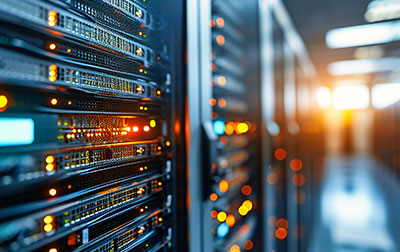Resilient power supply: Enabling the future of data center growth

As demand for digital applications, cloud services, and artificial intelligence (AI) soars, the growing energy consumption, coupled with the increasing reliability expectations on the electricity grid, presents both an opportunity and a challenge for utilities and data centers alike.
The power surge: A reflection of digital growth
Data centers are the backbone of the modern economy, hosting everything from financial transactions to machine learning models, and facilitating the growth of technologies that drive everything from healthcare to e-commerce. However, as these centers expand to meet the data flows expected from billions of connected devices, the energy they require is on an upward trajectory: A January announcement from the North American Electric Reliability Corporation (NERC) indicated that half of the country looks to be facing near-term energy shortages as electrification and data centers are expected to increase peak demand by 122 GW.
According to Berkeley Lab’s report, the total electricity consumption of U.S. data centers could increase by up to 30% by 2030 and while the recently released DeepSeek R1 AI Assistant app demonstrates that innovation may reduce the rate of such energy growth, this inevitable surge in power demand raises a critical question: Can our electricity grid keep pace?
As digital infrastructure becomes more complex and geographically dispersed, utilities must be prepared for higher loads and more frequent peaks in demand, driven by everything from seasonal weather changes to global events that trigger spikes in data processing needs. In response, the development of the grid’s capacity to handle these fluctuations will be crucial—which means utilities must consider a range of strategies to ensure the grid remains reliable and resilient.
Challenges in providing reliable energy to data centers
For both utilities and data centers, meeting the growing demand for electricity involves four key challenges:
1. Infrastructure strain. The U.S. grid is already operating at or near capacity in several regions, particularly in areas where data center concentrations are already high, such as Northern Virginia, Silicon Valley, and Texas. Expanding infrastructure to meet the demand of a rapidly growing sector is a formidable task that will require large-scale investments in both new power plants, and the modernization and drastic expansion of existing transmission networks.
2. Intermittency of renewable energy. As utilities work to decarbonize and integrate more renewable sources like wind and solar, the challenge of balancing supply with intermittent generation becomes more pronounced. Data centers, with their heavy power needs, must be prepared to balance the availability of variable renewable energy, with other technologies such as advanced energy storage systems and flexible demand management strategies to manage these fluctuations. Small modular reactors (SMR) are answering the call by proposing to fill the baseload power gap with another non-emitting resource. SMR’s continuous energy supply can pair reliably with other energy storage solutions to create a more flexible, resilient electrical supply for data centers and grids alike.
3. Demand peaks and flexibility. Data centers often experience fluctuating and unpredictable power needs, especially with the rise of AI and real-time data processing. Balancing this demand with the grid’s capacity—especially during extreme weather events or sudden surges in traffic—will require increased grid observability and improved dynamic load management through technological and operational solutions. Data centers will need to adopt more advanced load forecasting systems, while utilities will need to enhance their grid monitoring capabilities to predict and react to these demand spikes in real-time.
4. Energy efficiency vs. growth. Although energy efficiency has become a key focus for data center operators, with many seeking to reduce their power usage through advanced cooling technologies, AI-driven optimization, and the use of renewable energy, the very growth of digital services creates an inherent tension. As companies expand their data processing power, energy consumption is bound to increase, regardless of technological advances. Balancing efficiency gains with the need for more computing power presents an ongoing challenge. Geographic selection of new data center locations, where possible, should account for local external weather and temperature patterns as cooler locations would require less cooling and would be naturally more energy efficient.
The path forward
The challenges outlined in Berkeley Lab’s 2024 report on US data center energy usage point to a future where data centers will be integral to the digital economy and to the evolution of the power grid itself. The path forward lies in the shared responsibility between utilities and data centers to design an energy ecosystem that is both flexible and resilient.
Data centers must continue to invest in energy-efficient technologies, while also engaging in deeper collaboration with utilities to ensure their energy needs are met without straining the grid. Utilities, for their part, must embrace innovative solutions like smart grid technologies, energy storage, and demand response programs to keep pace with the growing needs of the digital sector.
Ultimately, strengthening the grid to support the increasing power demands of data centers is not just about ensuring a reliable energy supply—it is about enabling the future of the digital economy and empowering new technologies that will drive economic growth, environmental sustainability, and innovation for years to come.
Stay tuned for Part 2 of our Berkeley Lab blog series, which will dive into leveraging SMR technologies in data center plans and will provide a step-by-step guide to building grid resilience. Connect with us to learn how we’re innovating energy solutions and building practical solutions that ensure critical operations have resilient and sustainable power infrastructure for the future.
